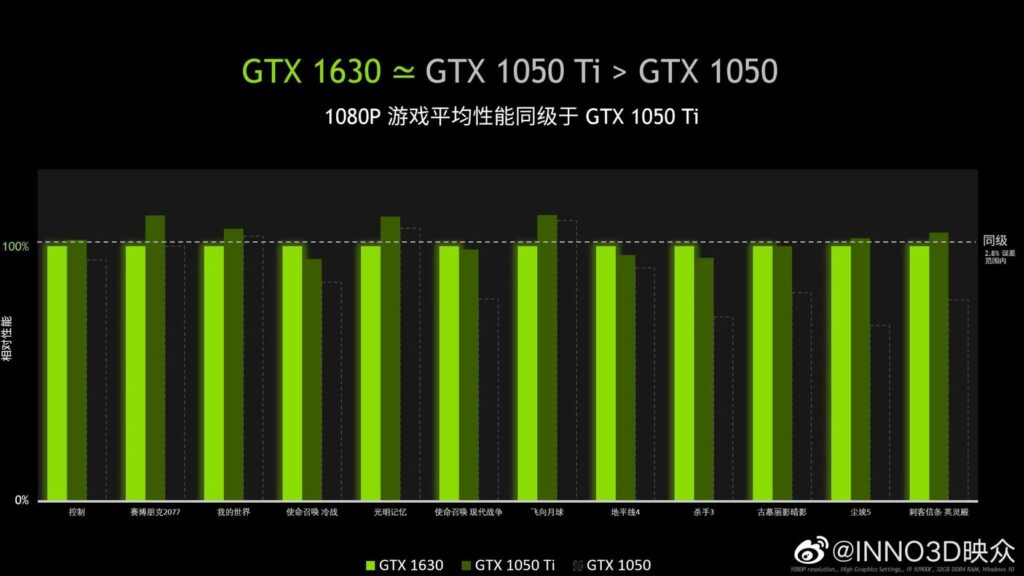NVIDIA also didn’t share any benchmarks of the card or compared it to its contemporaries. Reports have suggested that the 1630 card is supposed to replace the GTX 1050 Ti, though it has worse on-paper specs than the outgoing model. Some reviews of the GTX 1630 are out, namely from TechPowerUP and Guru3D, which show that the GPU is not exactly performant and quite bad for a gaming option in 2022. In fact, it couldn’t even beat the RX 6400, the slowest RDNA2 card that AMD makes. The only thing the 1630 has going for it is the newer Turing architecture, as compared to the 1050 Ti’s outdated Pascal architecture.
GTX 1630 is comparable to GTX 1050 Ti
A reference model for the GTX 1630 doesn’t exist so third-party variants are your only option. One of those third-parties is INNO3D who revealed their 1630 design yesterday. And today, the company has dropped official benchmarks for the 1630, comparing it against the GTX 1650 (non-Super) and the GTX 1050 Ti. The card was tested at 1080p across 12 titles, ranging from least-demanding to AAA. As you can see in the picture above, the GTX 1630 is on-par with the GTX 1050 Ti, which means the rumors positioning the card as a GTX 1050 Ti successors were correct after all. According to the INNO3D, the GTX 1630 is about as powerful as the 1050 Ti in most games, while the 1050 Ti does take the lead in some titles. The card is also about 17% faster than the non-Ti GTX 1050 with the biggest differences showing in modern titles like Cyberpunk 2077. Gaming aside, INNO3D points out how the GTX 1630 is a better professional GPU as it features a more capable media encoder that supports their VP8 codec, along with H.265 (HEVC) video. The GTX 1050 Ti doesn’t support either of those due to its older architecture. The GTX 1630 is an interesting SKU as it really has no reason to exist. The best explanation for why NVIDIA even made this card is that maybe the company just wanted to clear its Turing inventory as quick as possible. After all, the card has fewer CUDA Cores than the GTX 1050 Ti, along with a reduced memory bandwidth, not to mention that it’s more expensive, too. While there exists no MSRP for the card, the cheapest aftermarket variant right now is from COLORFUL and is priced at $169 while EVGA is selling their GTX 1630 SC for $199. The GTX 1050 Ti, on the other hand, came out in 2016 with a retail price of just $139. When you take all of that into account, it really doesn’t make sense why the 1630 costs more. NVIDIA GeForce GTX 1630 is the company’s latest entry-level offering featuring a TU117-150 GPU with 512 CUDA Cores, 4GB of GDDR6 memory running across a 64-bit wide bus interface, and a 75W base TGP. It boosts up to 1785MHz and is manufactured on TSMC’s 12nm process node. The card is mostly aimed at the OEM segment where system integrators will snatch up majority of the supply to utilize the video outputs of the GPU, when paired with a CPU with no integrated graphics. For a card this weak in gaming, it wouldn’t be an ideal choice for budget-oriented players.
